It was an ideal Saturday night earlier this month on Charlottesville, Virginia’s broad pedestrian mall. Jalane Schmidt, a professor of religious studies at the University of Virginia, was walking back from getting tea with a friend. All around her, couples were out for an evening on the town, and groups of friends sat in front of the hip restaurants that line the walk.
Then she saw it: White supremacist protesters with torches were walking toward a shrouded statue of Confederate General Robert E. Lee in Emancipation Park.
“The first thing [I felt] was anger,” Schmidt told ThinkProgress. “Like, ‘Not again!'”
Schmidt, a black woman who co-founded the local Black Lives Matter chapter, was shaking with fear and anger. Still, she ran toward the 50-some-odd white supremacists. They were chanting “you will not replace us,” making speeches, and singing the unofficial Confederate anthem, “Dixie.” She quickly sent out an alert for other activists to join her. Then she got closer, taking photos of the white supremacists’ faces so activists could identify them later, before the brief, flash mob-style rally disbanded.
About a dozen Charlottesville police watched the torch rally, Schmidt said, but “did nothing” despite a Virginia law that makes it a felony to burn an object in public to make others fear for their personal safety. The Charlottesville commonwealth’s attorney, Dave Chapman, later declined to press charges for the incident.
Schmidt explained that she and other activists have honed the process for responding to incidents like this over months of similar protests in this liberal college town. “I was [afraid], but I just had to work through it, because that’s what we do,” she said.
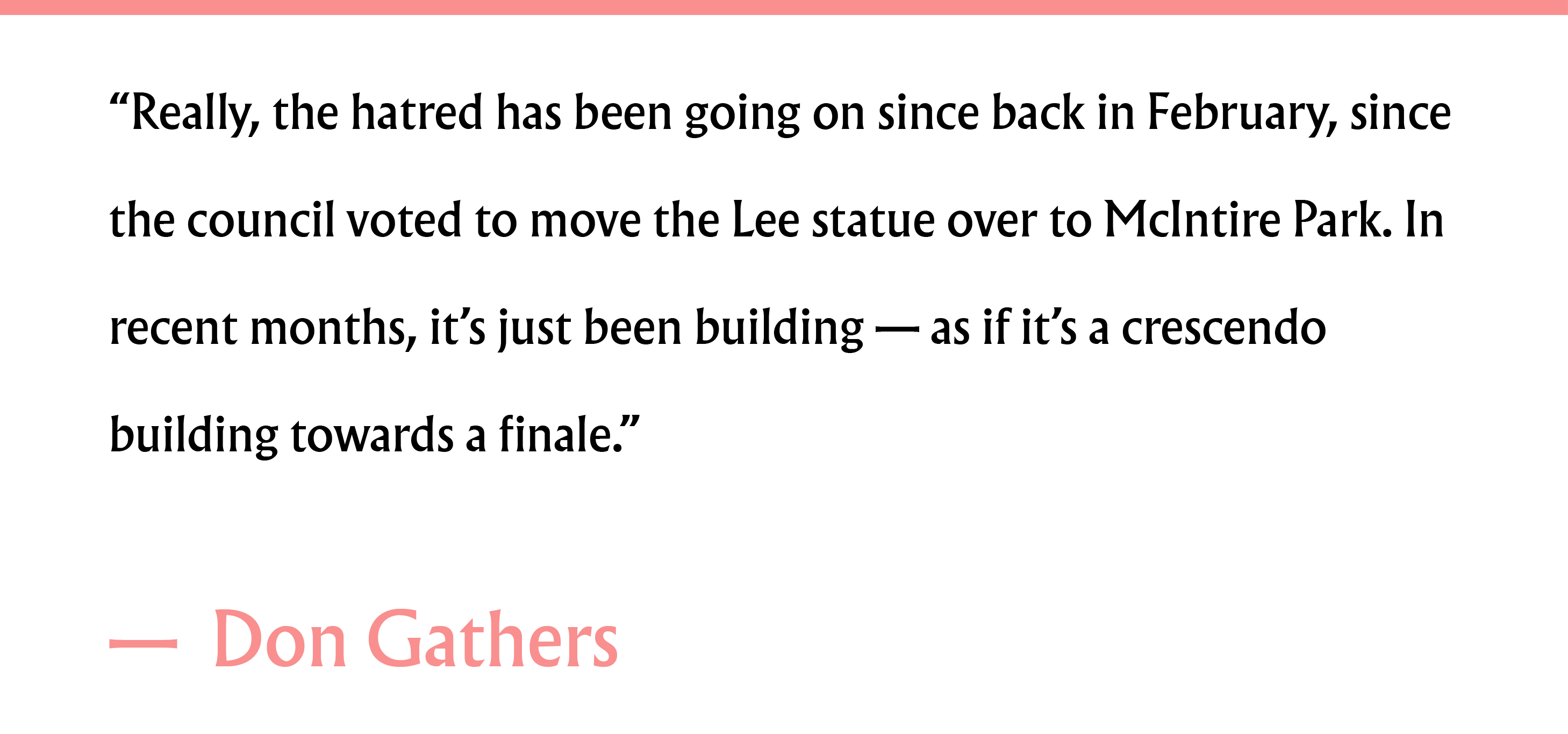
Charlottesville made national headlines in August, when hundreds of white supremacists rallied against the city’s plans to move the Lee statue. That day, a driver plowed through anti-racism protesters, killing one and injuring at least 30. The day of violence drew intense national media attention. But Charlottesville has been a target of white supremacists for months, with the movement’s leaders and groups making frequent visits to rally, organize, and harass local residents. It was a target before the nation turned its eyes toward the small town, and it’s remained a target after the news cycle has moved on.
Meanwhile, activists say the local government and law enforcement have turned a blind eye to the unrest, even as they shared their concerns with officials.
ThinkProgress has interviewed more than 20 local anti-racism activists, politicians, organizers, clergy, and business owners since the August violence. They painted a picture of a city “under siege,” as one described it, with white supremacists targeting individuals for intimidation, casing activist meeting places, and yet again rallying at the sight of the events in August. But those activists also told ThinkProgress how the community has organized to defend itself and fight back against the white supremacist assault.
“Really, the hatred has been going on since back in February, since the council voted to move the Lee statue,” said Don Gathers, who co-founded the local Black Lives Matter chapter with Schmidt and chaired a blue-ribbon commission that made recommendations about the statue. “In recent months, it’s just been building — as if it’s a crescendo building towards a finale.”
A small town starts to reckon with its troubled past
Charlottesville grew up in the shadow of the University of Virginia and Thomas Jefferson’s plantation, Monticello — both built with slave labor. When Union soldiers took the city on March 3, 1865, 52 percent of its residents, or 14,000 people, were enslaved.
Instead of recoiling at that history, the city celebrated it. The wealthy financier Paul Goodloe McIntire donated the Lee statue and the park that surrounds it in 1924 to commemorate the Lost Cause, a romantic view of the Confederacy and the antebellum South.

Even as segregation fell and Charlottesville developed a reputation as a liberal bastion, deep racial divides remained half-buried. A ThinkProgress investigation in August, for example, found that the city’s black residents were nine times more likely to be stopped by city police than white residents during the first half of 2017. And groups like the Charlottesville Public Housing Association of Residents have long criticized what they say is a lack of affordable housing for the city’s black residents.
Many Charlottesville residents and activists who spoke with ThinkProgress expressed frustration with what they described as an affluent, progressive image that belies deeper divisions within the city.
“The more I learn, the more I’m convinced Charlottesville hasn’t really changed [since segregation],” said longtime Charlottesville lawyer and activist Pam Starsia, who now lives in Austin, Texas. “We have more yoga studios. That’s about it.”

Things began to shift in March of last year. Local high school student Zyahna Bryant started a petition that called on the city to remove the Lee statue, and Vice Mayor Wes Bellamy (D) took up the cause. Last May, the city formed a blue-ribbon commission to review its Confederate monuments.
At first, Schmidt recounted, very few people attended the commission’s meetings, and most were older white people who supported keeping the statues. So she started organizing with other local activists to turn statue opponents out.
“Over the period of six, eight months, the opinions that were expressed at these meetings swung 180 degrees, and the vast majority were in favor of removal,” Schmidt said.
The commission’s report, released in December, recommended either moving the Lee statue to an outlying park or re-contextualizing it in place. By February, the City Council had voted 3 – 2 to remove the statue, and in April it voted, again by 3 – 2, to sell the statute altogether. Those votes are the subject of an ongoing lawsuit that seeks to keep the statues in place.
As the city was wrestling with the darkest parts of its history, President Donald Trump winked and nodded toward white supremacy — first from the campaign trail, then from office. Trump’s rhetoric emboldened the far right, and a new white supremacist movement called the “alt-right” began to spread on social media and internet forums.
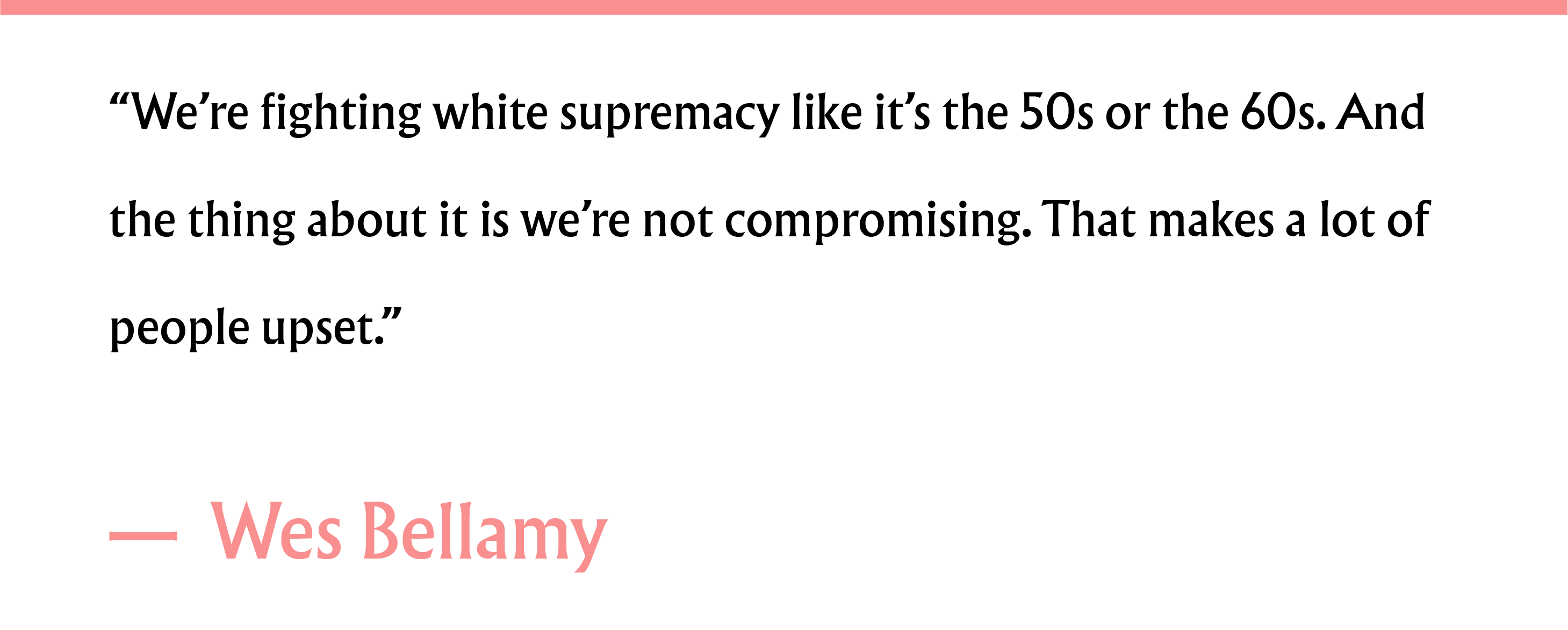
In Charlottesville, a previously unknown white-supremacist blogger named Jason Kessler took aim at Bellamy, the city’s black vice mayor. In a November 2016 post on his now-deleted website, Kessler published tweets Bellamy sent between 2009 and 2014 that disparaged women and white people. Kessler filed a recall petition that went to court before ultimately failing, and Bellamy stepped down from an appointed position on Virginia’s Board of Education.
Speaking at a City Council meeting, Bellamy apologized for his “indefensible” tweets and said they were the product of the “arrogant young man” he used to be, according to C-VILLE Weekly. In an interview with ThinkProgress, Bellamy drew a clear line between his work to remove the Lee statue and Kessler’s recall campaign.
“We’re fighting white supremacy like it’s the 50s or the 60s,” Bellamy said. “And the thing about it is we’re not compromising. That makes a lot of people upset.”
Starsia, who represented Bellamy in his court fight against Kessler’s recall petition, was active with the Charlottesville advocacy group Showing Up for Racial Justice. She says the group is mostly composed of white, liberal members who took a while to appreciate the threat Kessler posed. The group debated whether it should ignore him as an attention hound or confront him head-on. Finally, she says, radical activists of color convinced them that Kessler was dangerous.
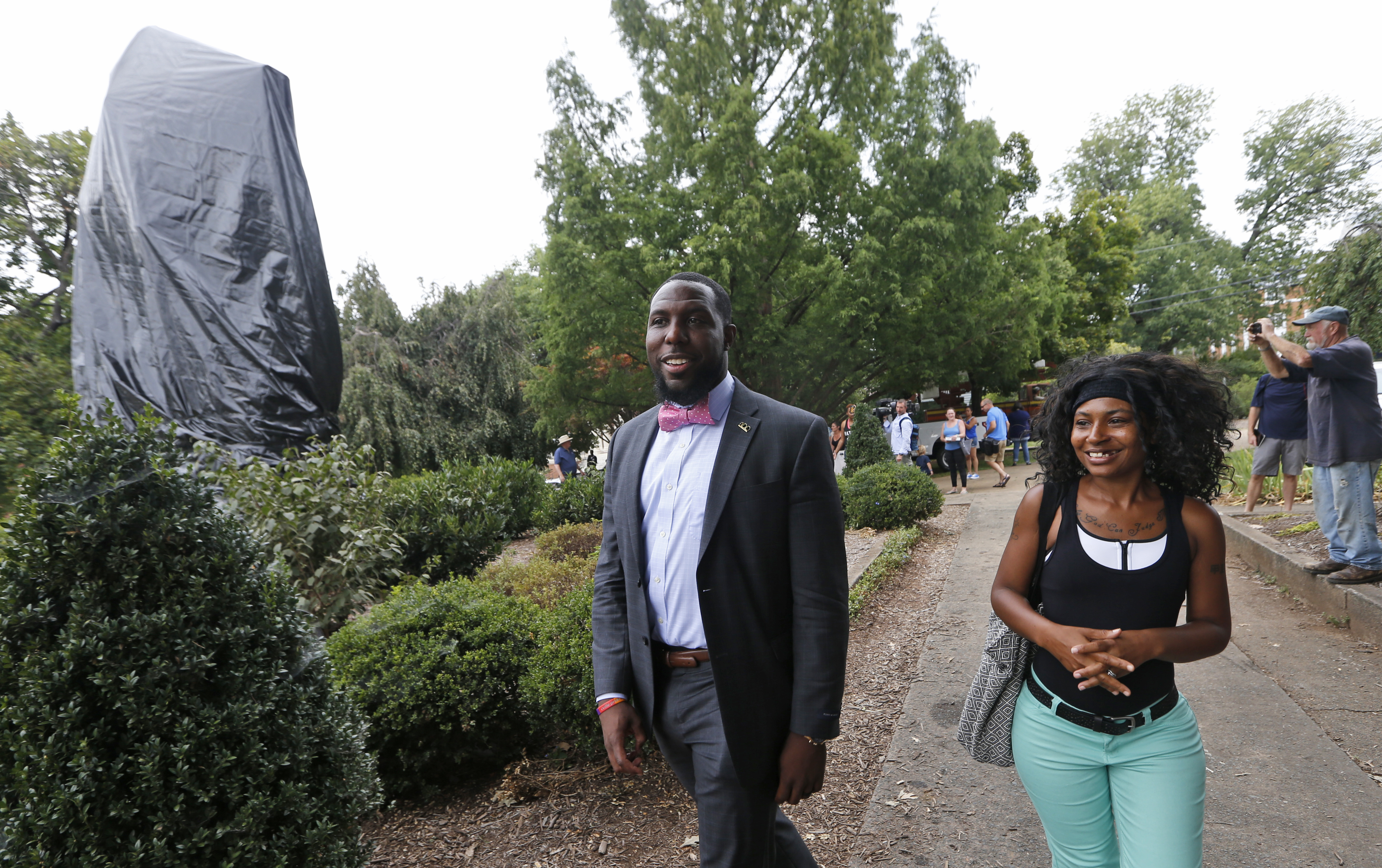
Reached through intermediaries, several of those activists declined to be interviewed. However, several people who spoke with ThinkProgress emphasized the important role these activists of color played.
“There was a group of activists that were prominent in Charlottesville even as far back as the Occupy days,” said local Black Lives Matter activist David Vaughn Straughn, referring to the period in late 2011 when Occupy Wall Street inspired protests against economic inequality across the country. “Black and brown women and femmes pretty much started the activism in Charlottesville that we see today.”
After torch rally, the scales fell from their eyes
Gail Hyder Wiley, 59, says the past year has pushed her outside her comfort zone. Wiley and her husband are elders at Westminster Presbyterian Church, and she described the experience of waking up to white supremacy — and her own privilege — in religious terms. “The scales are falling from our eyes,” she said, alluding to the biblical story of Paul the Apostle, who was struck with temporary blindness after a vision of Jesus that lead to his conversion.
When Wiley couldn’t attend the Women’s March in Washington, D.C., after Trump’s inauguration in January because of health problems, she organized a Charlottesville rally she says drew some 2,500 people. Through a Facebook group that grew out of the rally, Charlottesville Gathers, Wiley and her husband organized trainings on nonviolence and bystander intervention. But, she says, their activism was still “timid” and “whitebread.”
Just a few months later, Wiley would play a behind-the-scenes role with other anti-racism activists during the Unite the Right rally. Her journey there began on May 13. She was walking near Charlottesville’s annual multicultural festival when she noticed a group of people holding Confederate flags at a nearby park. The white supremacist rally she’d stumbled on would set off months of protests and counter-protests in the liberal bastion.
Mimi Arbeit, a research fellow in education at the University of Virginia, was watching Netflix on her couch when she got a text that prominent white supremacist Richard Spencer, who popularized “alt-right” as a media-savvy euphemism, and his followers were rallying downtown. Her fellow activists were concerned that white supremacists might try to disrupt the nearby multicultural festival.
Arbeit was nervous about confronting white supremacists in person, she said, but she didn’t want to feel regret later when she asked herself what she’d done when Nazis came to her town. She threw on her favorite, bright-pink hoodie and went to confront them.
When she arrived, a handful of anti-racism activists watched as the white supremacists made speeches and walked near the nearby cultural festival. Several tried to take a picture with the festival’s German table, but organizers stood in the way of their photo. While a few Charlottesville police were monitoring the situation, activists wanted to be there to defend their community, if necessary, and let the white supremacists know they weren’t welcome, according to Arbeit and Wiley.
That night, Kessler, Spencer, and dozens of other white supremacists held their first torch-lit rally at the Lee statue. They chanted “you will not replace us,” “Russia is our friend,” and the Nazi slogan “blood and soil” for about ten minutes while posing for dramatic pictures in the torch light, according to The Daily Progress.
“That incensed both of us, my husband and me,” Wiley said. “That’s when we started attending more meetings.”
All the anti-racism activists who spoke with ThinkProgress pointed to the May 13 torch rally as a turning point for both sides. People who hadn’t taken the white supremacist threat seriously before began to pay attention, they say. Groups began to organize, and people who wouldn’t normally work together decided to take action.
“Prior to that, the townspeople had been upset with us anti-racism activists,” Schmidt said. “But after that happened on May 13, people were mortified. Just regular, rank-and-file people were mortified.”
At the same time, Kessler and other known white supremacists became much more active in town, according to Starsia. By May 30, Kessler had filed an application with the city for a “free speech rally in support of the Lee monument.” Anti-racism activists would see him meeting for dinner with other white supremacists at the bars and restaurants that line Charlottesville’s downtown mall.
“You could tell the torch rally emboldened Kessler,” Starsia said.
White nationalists feel emboldened; activists get organized
On June 5, Kessler announced his August 12 “Unite the Right” rally via Twitter:
In response to crackdowns on civil liberties I'm holding a #UnitetheRight free speech event in Charlottesville's Lee Park August 12th @ 12pm
— Jason Kessler (@TheMadDimension) June 5, 2017
It was around the same time that the Loyal White Knights of the Ku Klux Klan, based in North Carolina, made public their plans for a separate rally in Charlottesville on July 8.
That’s when anti-racists activists got more serious about preemptively confronting white nationalists in town. Local activists with Showing Up for Racial Justice and other anti-racism groups began to confront Kessler and his associates when they went out in public, surrounding them on the downtown mall and calling restaurants to ask that they refuse the white supremacists service. Before long, these confrontations were happening nearly every weekend.
Initially, many downtown businesses feared they could wind up in legal trouble for denying Kessler and other white supremacists service. Organizing the restaurants became more urgent in mid-June, when activists learned Kessler was going to meet downtown with several members of the Proud Boys, a “pro-Western fraternal organization” that says it rejects white supremacy but has close ties to white supremacist organizations.
#ProudBoys and #AltRight headed to downtown #Charlottesville pic.twitter.com/itVIA9VPjf
— Alt Right Va (@AltRightVa) June 17, 2017
Mike Rodi, who owns the restaurant Rapture, says Kessler and his friends harassed some of his employees after the May 13 torch rally. “Staff said, ‘Hey, do we have to serve these white supremacists?’ And I said, ‘Hell no.'”
When Rodi heard about the Proud Boys’ visit in mid-June, he met with a few other local restaurants to strategize how they could decline them service. By the time Kessler and his friends arrived downtown, activists say, almost no restaurant or bar on the pedestrian mall would serve them. They ended up standing outside Violet Crown, a local cinema and bar, while locals confronted them.
“Just regular people totally got in their faces and started yelling at them,” Schmidt said. “That’s when things kind of changed.”

In late July and early August, activists put together a pamphlet for downtown businesses with details on the upcoming Unite the Right rally, pictures of prominent speakers, and legal information. It was important to let businesses know that they could decline service to known white supremacists because political belief is not protected in the same ways as race, gender, or religion under state and federal law, according to Schmidt.
“Being a racist asshole is not a protected class,” she said, laughing.
Meanwhile, Rodi emailed every local business owner he could think of, inviting them to an open meeting at Rapture to discuss Unite the Right. By the time the meeting came, he says, around 50 business owners and activists showed up to ask questions and strategize. The participants formed an email list to keep each other informed and started dividing up tasks — looking into private security for businesses, organizing escorts to make sure employees got to and from their vehicles safely, creating signs that businesses could display in their windows to show their opposition to white supremacy.
“That’s behind-the-scenes stuff,” Schmidt said. “Everyone sees the stuff on the streets, but they don’t see the thousands of hours that go into it.”
When they weren’t organizing local businesses, activists were organizing themselves. In late May or early June, Schmidt and Gathers formed a local Black Lives Matter chapter to counter the growing white supremacist threat. Around the same time, a “spokes council” also formed — a model for organizing coalitions where each group’s representative acts as a spoke of the wheel that can share their concerns in turn.

To stand up a united front going into the Klan rally and Unite the Right, activists from Black Lives Matter, Showing Up for Racial Justice, a clergy group called Congregate Cville, and others formed an umbrella organization called Solidarity Cville.
Leslie Scott-Jones, a local radio host, joined the Black Lives Matter chapter and Solidarity Cville after getting a call-out for members from her old friend David Vaughn Straughn. She says the umbrella organization and the spokes council were a way for people with different approaches to activism, different tactics, and different politics to work together toward common goals.
“I was really amazed at how well all of these different people who were working with organizations whose platforms may not align, but were definitely in the fight for the right reasons, came together,” Scott-Jones said.
The Rev. Seth Wispelwey, a United Church of Christ minister based in Charlottesville, held an invitation-only nonviolence training before the July 8 Klan rally with the Rev. Osagyefo Sekou, a longtime activist and veteran of the protests in Ferguson, Missouri. [Full disclosure: Sekou is this reporter’s friend and former editor.] The morning before the rally, the Charlottesville Clergy Collective held a short interfaith prayer service attended by 500 people at First United Methodist Church.
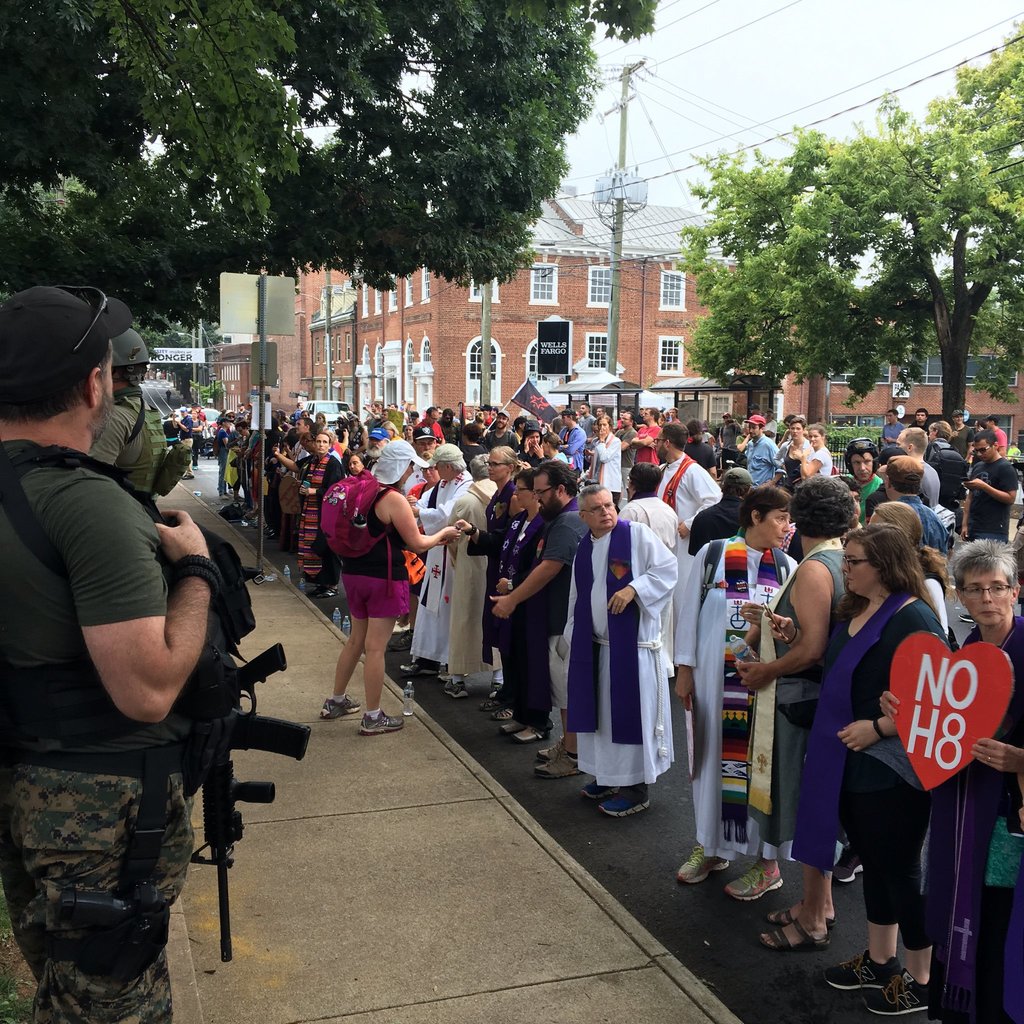
After the service, nearly 400 people marched from the church to the site of the rally to join around 600 other people protesting the 50 or so klansmen who rallied around a statue of Confederate general Thomas “Stonewall” Jackson in a downtown park not far from the Lee statute. It was a muggy Virginia summer day, and Wispelwey was sweating through his heavy clergy robes. But the oppressive heat wasn’t enough to dampen what Wispelwey described as a spirit of “jubilance and defiance” among the counter-protesters as they drowned out the Klan with songs, chants, and drumming.
The mood turned after the police escorted the Klan out of the park and to their vehicles, according to Wispelwey. At first, he said, the police declared an unlawful assembly but didn’t make any moves to enforce their declaration. Then, seemingly out of nowhere, the police fired tear gas.
“It was surreal to see,” said Wispelwey, who saw a tear-gas canister shoot over his shoulder before feeling the chemical’s acrid sting. “Preemptively, there was a heavily militarized police response in our self-satisfied, bucolic, progressive college town.”
Afterward, Charlottesville Police Chief Al Thomas told the the Richmond Times-Dispatch that Virginia State Police only deployed tear gas when some counter-protesters began to assault police — a claim activists who were at the scene denied.
“Our goal was to get the Klan out of our city as quickly as possible,” Thomas reportedly said. “We had several hundred people try to block that and keep them here. That’s where we were at odds.”
After the police crackdown on July 8, Wispelwey said, many people felt like they needed more training in how to stay safe and nonviolent at protests before August 12. At the time, the Clergy Collective wasn’t able to provide that kind of support.
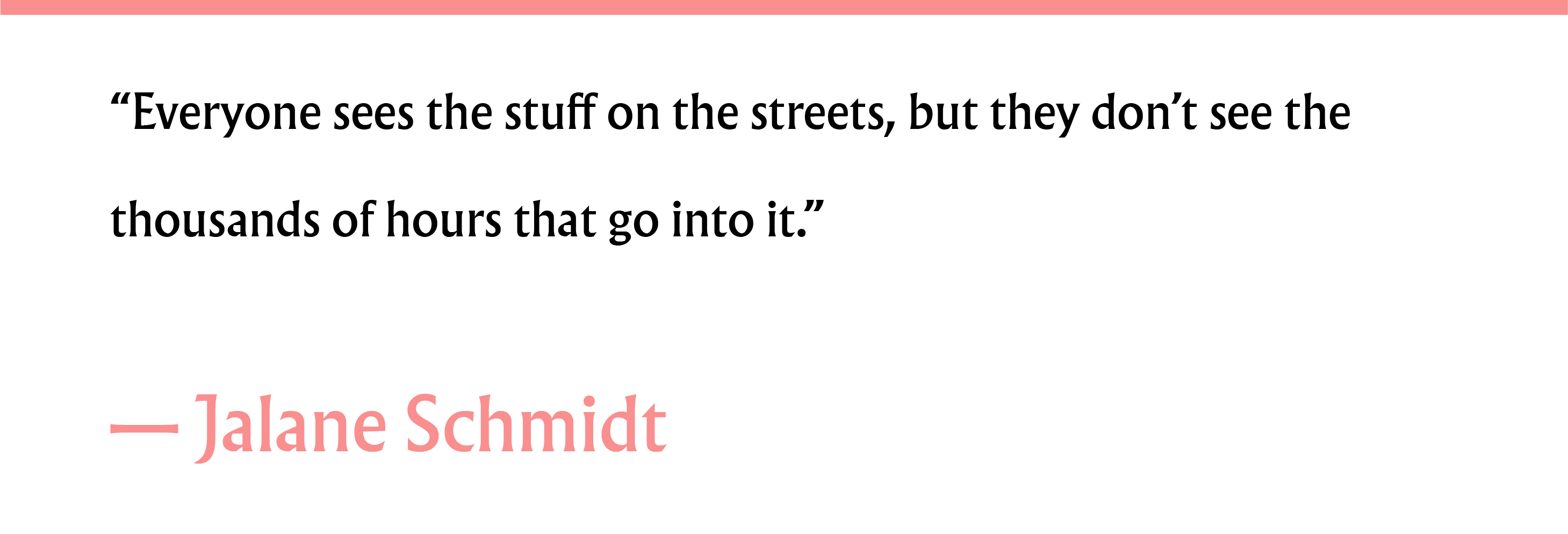
Wispelwey and another local minister, Brittany Caine-Conley, knew they had to do more. They decided to form Congregate Cville — “[l]ess of a group and more of an instrument for organizing faith leaders,” as its website says. Caine-Conley and Wispelwey asked Sekou back to Charlottesville for the next six weeks, alongside other trainers who had experience working in war zones. They wanted to train people for nonviolence in the worst-case scenario, Wispelwey said. They put out a national call for clergy to join them. Every Wednesday night, they gathered to pray, sing freedom songs, and run through practice scenarios.
It was heavy work, Wispelwey said, and not everyone felt comfortable joining the clergy’s nonviolent protest at Unite the Right after going through the training.
“We were very clear that there was a high risk for arrest or physical harm — or even perhaps death,” Caine-Conley said. “We wanted people to be fully consenting to be in a space where there was so much danger.”
As Caine-Conley and Wispelwey were organizing their fellow clergy, the Solidarity Cville spokes council, which included Congregate Cville, was building out its infrastructure for Unite the Right. By the time August 12 came around, according to Schmidt, activists had lined up street medics, legal support, a bail fund, intelligence, and food and water distribution.
Violence on the streets of Charlottesville
The day of the rally, Schmidt said, volunteers produced multiple live streams to show what was happening on the ground. While her husband was at the rally, Gail Hyder Wiley monitored white supremacist social media accounts to relay information to people on the ground. Walter Heinecke, a professor of education at the University of Virginia, got a permit for two parks near the rally that activists used as safe, off-site spaces complete with private security and volunteer marshals who looked out for white-supremacists who might try to disrupt or attack them.
At the rally in Emancipation Park, where the Lee statue stands, things devolved quickly. White supremacists and anti-racism protesters squared off with homemade shields, pepper spray, and projectiles. The hundreds of city and state police and national guard soldiers who were passively watching the rally or on standby near it failed to act until around noon, when they declared an unlawful assembly and moved in to disperse the crowd. The melee around the park scattered into parking lots, garages, and side streets. The few downtown businesses that were open quickly closed as Virginia Gov. Terry McAuliffe (D) declared a state of emergency. Rumors flew about white supremacists pulling weapons near churches and other locations where anti-racism activists were holed up, and video published later by The New York Times showed a white supremacist firing a gun at an anti-racism protester as he left Emancipation Park. The city felt like a war zone.
A few blocks away from Emancipation Park, Todd Howard opened up his restaurant and bar, Escafé, to Congregate Cville. Outside, a private security officer dressed in black fatigues stood guard, a sidearm on his hip and a shotgun in his hands. Inside, clergy, local activists, and journalists — including this reporter — took shelter from the violence and the oppressive heat outside, charged their phones, and fortified themselves with food and drink on the house. [ThinkProgress reporters paid for their own meals.]
Katie Couric interviewed famed Harvard professor Cornel West in one corner. In another, activists got updates on the scattered protests outside and strategized where clergy might be needed to help de-escalate. Guess Who’s Coming to Dinner played on the bar’s TVs. At one point, everyone moved to the back of the building while the security guard checked out a suspicious person who seemed to be casing the building. “That’s when it became scary for me,” Howard said. “Really scary.”
Several tense minutes passed, with those huddled inside discussing possible escape routes, before the guard gave the all-clear.
Just a few blocks away, Brandon Collins was walking with a friend near the Friendship Court public housing development. Collins, an organizer with the Charlottesville Public Housing Association of Residents, had reached out to the Charlottesville City Council before Unite the Right to talk about setting up a parking plan for the day that would keep white supremacists away from public housing.
Only Vice Mayor Bellamy responded, according to Collins. Council Member Kathleen Gavin (D) also emailed City Manager Maurice Jones with Collins’s concerns, according to an internal memo published in August by the Richmond Times-Dispatch. When the city’s final parking plan for the rally failed to take Friendship Court residents’ concerns into account, Collins said, residents took security into their own hands.
“We had observers in the neighborhoods on our own, because we knew the police wouldn’t be there,” Collins said.
As Collins and his friend walked near Friendship Court, they came across a large march of anti-racism protesters that was going to help defend the housing project from white supremacists who’d been seen in the area after police dispersed the rally. When residents said they had the situation under control, Collins and his friend asked the marchers to turn back. It didn’t feel like a defeat for the marchers, Collins said, but a victory.
“They were elated when they left,” he said. Minutes later, neo-Nazi James Fields Jr. rammed his car into the same group, killing 32-year-old Heather Heyer and wounding at least 30 others.
‘They’re coming back. But we’re ready for them.’
In the aftermath of August 12, many questioned why police didn’t do more to stem the violence. City officials, including Bellamy, insist they never told police to stand down. But many local residents who spoke with ThinkProgress said they still don’t trust the police to protect them from white supremacists.
Charlottesville police did not return requests for comment.
Ten days after the rally, the Charlottesville City Council voted unanimously to shroud the Lee and Jackson statues with large black tarps. Within days, someone removed the tarp from the Lee statue overnight.
If the white supremacist groups that descended on Charlottesville seemed briefly weakened by the negative media coverage after August 12, they’ve regrouped in the meantime. “It was a great success, and we’re going to do it again,” Spencer said in a video posted to his Twitter account after the torch rally earlier this month. “This definitely is a model that should be repeated.”
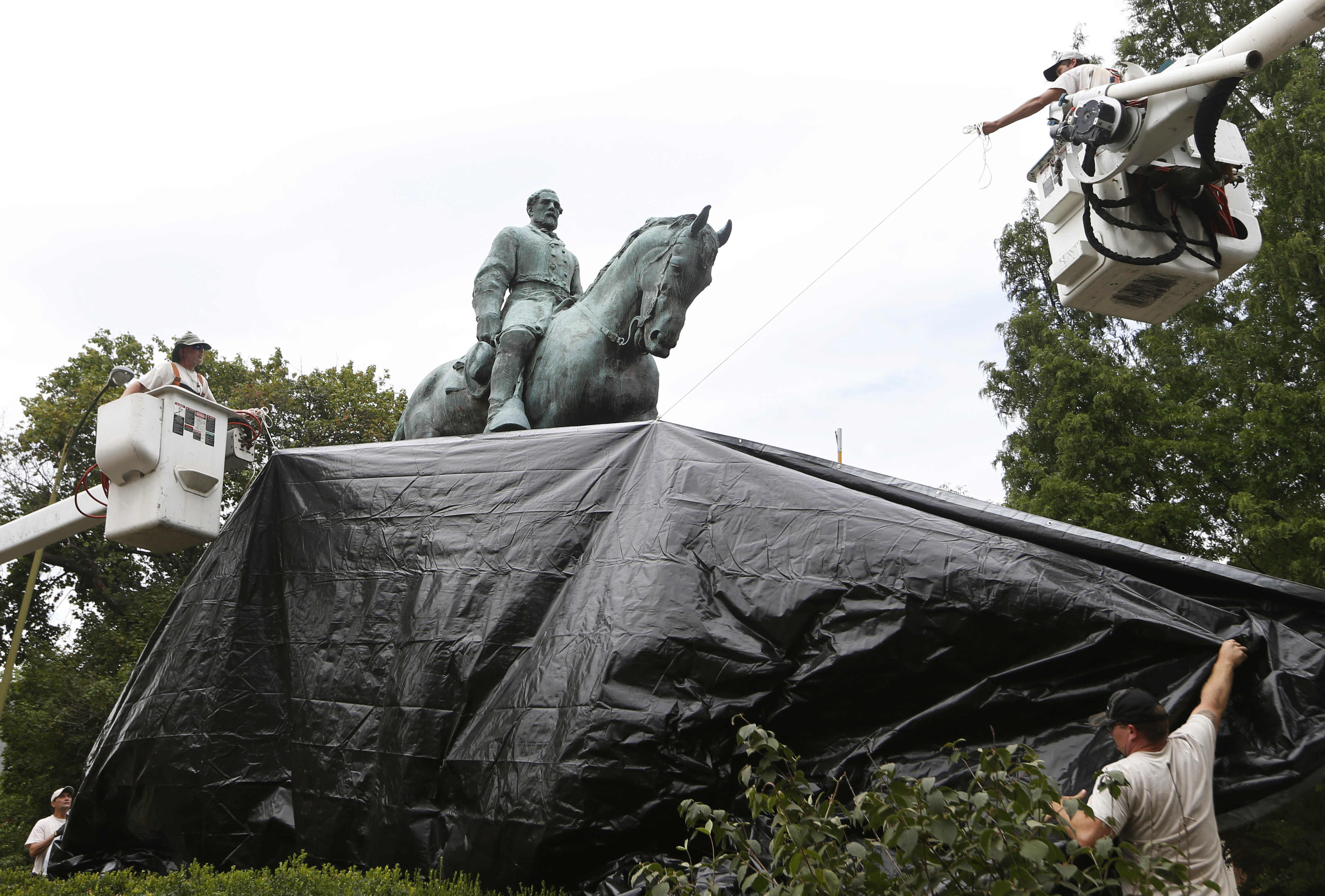
Many activists say they feel caught between the city and police, on one side, and white supremacists, on the other. White supremacists based in Charlottesville continue to harass anti-racism activists, they say, while the threat of another big rally — like the torch rally Schmidt stumbled on earlier this month — is always looming around the corner. But as they face an uncertain future and lick their wounds, anti-racism activists in Charlottesville are leaning on the networks of solidarity and support they’ve built over months of protest.
Whatever happens with the Lee statute, activists say they’re prepared
“These alt-right folks are going to be back, either for a protest rally or a victory parade,” Schmidt said. “They’re coming back. But we’re ready for them. We have an infrastructure that’s very strong. It can be re-activated at a moment’s notice.”
Correction: An earlier version of this story incorrectly identified the site of a July 8 Klan rally in Charlottesville. It was held at a statue of Stonewall Jackson, not at the nearby statue of Robert E. Lee.


